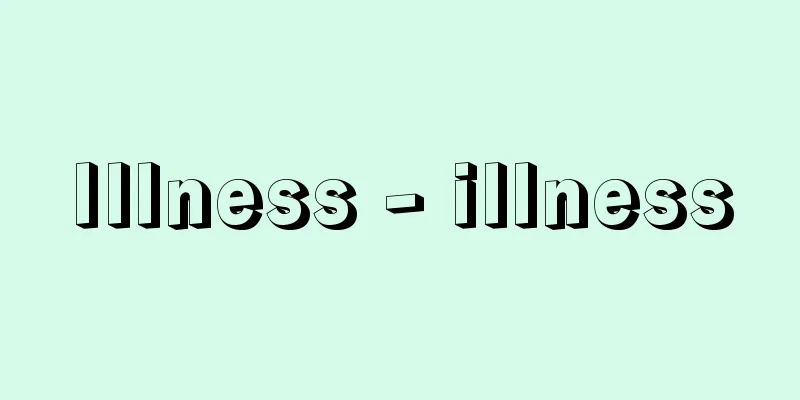Illness - illness

|
In medicine, illness is often defined as "discontinuance, cessation, or impairment of bodily functions, structures, organs, etc.", that is, a deviation from the normal state, but the concept of "normal" itself is uncertain. When you get to the bottom of it, you fall into the contradiction of semantic repetition of "not being abnormal." It is difficult to define illness from a natural science perspective. The 17th century British physician Thomas Sydenham considered disease to be an entity just like animals and plants, and attempted to classify diseases in the same way as zoology and botany. However, this attempt failed. Similar attempts have been made many times since then, but have not been successful. This is simply because the initial assumption that disease is an entity was incorrect. Regarding the nature of disease, American medical scientist Engelhardt and others proposed the idea that "the concept of disease is constructed by the values and beliefs of the culture and society to which the sick person belongs." In other words, disease is a concept that is heavily intertwined with aspects of cultural and social decisions rather than an entity. [Akira Nakagawa] Disease conceptAs mentioned in the previous paragraph, it is difficult to give a definition that applies to illness in general, because illness is primarily a sociological and behavioral concept. However, behind this concept is the assumption of the existence of something that interferes with daily activities and that one wishes to remove. One of them is a natural entity. Its existence allows a person to be fully or partially exempt from everyday responsibilities, to avoid moral responsibility, and to receive assistance, including medical treatment, which is socially recognized as legitimate. In other words, being natural means that it is considered to be unrelated to the will of the sick person, so there is no way to take responsibility, and because of this, the person's abilities are reduced. This means that professional assistance is needed in addition to assistance from those around them. In many societies, doctors are the basis of such professional assistance. Doctors can make such natural entities effective by clarifying them according to the principles of explanation of natural things that are widely accepted in each era. To be more specific, doctors clarify the existence of illness based on medical science, but in many cases, the doctor's thought process and the illness that is revealed as a result of this cannot be seen directly, so the diagnosis is also made by the doctor. In other words, illness is posited as a sociological procedure. The other is personal circumstances. Since it is a disaster that torments an individual and poses a great threat to one's destiny, one cannot find a way to be liberated from it unless one understands the personal circumstances that have brought about such a state. Particularly in pre-modern societies, many personal circumstances were sins, curses, or trials for delinquency or immorality. These differences depend on cultural background and individual differences, but what they have in common is that they are pursued retrospectively. And when one is able to understand one's current symptoms and suffering, it provides an opportunity to be liberated from them. Generally speaking, the older type of medicine is associated with the latter, that is, with understanding personal circumstances, while the newer type of medicine is associated with the former, that is, with grasping natural entities; but in the case of mental illness, it is difficult to understand natural entities, so it is often treated retrospectively as something personal. [Yonezo Nakagawa and Akira Nakagawa] Changing concepts of diseaseHistorically, there have been various ways in which illness has been understood, but until the establishment of modern medicine, natural entities and personal circumstances were largely within the same explanatory system, and medical professionals who treated illnesses also developed their techniques in accordance with that explanatory system. In ancient Egypt, illness was thought to be caused by the invasion of evil spirits or a struggle between gods, that is, when the good forces are overpowered in a battle between good and evil. While seeking an interpretation for such illnesses, medical practitioners, who were also priests, determined prognosis from the combination of symptoms and prescribed treatment methods that combined experience and prayer. In Mesopotamia, illness was primarily seen as a punishment for misdeeds committed, and diagnosis and treatment methods also combined experience and prayer. Eventually, when natural philosophy, separate from religion, was established in ancient India, Greece, and China, illnesses came to be understood according to its principles, and medical treatment was based on that understanding. In India, the body is considered to be composed of three elements: mucus, air, and bile; in Greece, for example, the body's functions were understood in terms of four bodily fluids: blood, mucus, bile, and black bile; and in China, bodily functions were considered in terms of the flow of qi and blood, or water, and natural properties were classified into yin and yang, and changes were explained. In each country, the symptoms of illness were understood in relation to these basic elements. It can be said that Japan's understanding of illness was largely influenced by China. This understanding continued until modern medicine was established in Europe. In modern medicine, illness is considered to be an entity within the body. Therefore, symptoms are said to be an expression of that entity. In contrast, in pre-modern medicine, symptoms themselves were considered to be illnesses, and illnesses were generally considered to be reactions to harmful environments or harmful causes. [Yonezo Nakagawa and Akira Nakagawa] Modern medicine and diseaseIn modern medicine, diseases are first considered based on a combination of subjectively perceived symptoms and objectively perceived signs or findings, and attention is paid to whether they are reproducible with the characteristics based on systematic classifications such as the description of animal and plant species. When they are identified and reproducible, they are given the name syndrome. Then, by performing a pathological autopsy on a patient who exhibits such a syndrome, the cause of the syndrome is sought within the body, and when it is identified, it becomes the substance of the disease. However, for some diseases, even a pathological autopsy cannot find any changes corresponding to the syndrome. In this case, it is interpreted as remaining an abnormality in function, and it is called a functional disease (the former is called an organic disease). In organic diseases, abnormalities are first described at the macroscopic level, then at the tissue level and cellular level under a microscope, and gradually the description progresses to the microscopic level. Recently, the description has even reached the molecular level. If the disease can be identified in this way, the cause is pursued, but in some cases the cause remains unknown. Once the cause is identified, the description of the disease is considered to be complete with the addition of a syndromic and pathological anatomical understanding. However, the description of diseases is significantly different in nature compared to the description of animals and plants. This is because the description of animals and plants is based on the fact that they each exist in nature, and although there may be problems with the location of the species, it is possible to make a systematic classification. However, in modern medicine, there are functional diseases that have symptoms but cannot be supported by pathological anatomy as an entity, and even if a disease is organic, the relationship between the symptoms and the disease is statistical and there is no guarantee of inevitability. This is why many medical scientists have attempted to systematically classify diseases since the beginning of modern medicine, but have not been successful. [Yonezo Nakagawa and Akira Nakagawa] Classification of diseasesAs mentioned above, it is difficult to systematically classify diseases, but for the purpose of managing health administration, the World Health Organization (WHO) has established the following 19 classifications, with further subcategories below each. (1) infectious and parasitic diseases, (2) neoplasms, (3) diseases of the blood and hematopoietic organs and disorders of the immune system, (4) endocrine, nutritional and metabolic diseases, (5) mental and behavioral disorders, (6) diseases of the nervous system, (7) diseases of the eye and adnexa, (8) diseases of the ear and mastoid process, (9) diseases of the circulatory system, (10) diseases of the respiratory system, (11) diseases of the digestive system, (12) diseases of the skin and subcutaneous tissue, (13) diseases of the musculoskeletal and connective tissue system, (14) diseases of the urogenital system, (15) pregnancy, childbirth and the puerperium, (16) conditions occurring during the perinatal period, (17) congenital malformations, deformities and chromosomal abnormalities, (18) symptoms, signs and abnormal clinical and laboratory findings not elsewhere classified, (19) injuries, poisoning and other effects of external causes. Even with this classification, some questions can be raised. For example, in the case of infectious diseases, they are related to the organs of the digestive system, and in the case of neoplasms, when considering the site of origin, they are related to anatomical divisions. There is also the question of whether pregnancy and childbirth can be considered illnesses. However, considering that illnesses in modern times are considered to be conditions that can be treated by medical treatment, this classification does have some meaning. [Yonezo Nakagawa and Akira Nakagawa] Diversity in the view of illnessIllness is a state in which there is some abnormality in the body or mind that makes daily activities difficult or painful. However, the distinction between illness and non-illness varies depending on society and time, even though the conditions as human beings are the same. Malaria is a fairly serious disease, but a well-known example is that the Mano people of Liberia and the upper Mississippi River valley did not consider malaria to be a disease. The reason for this was that "everyone was suffering from it." Until recently in Japan, whooping cough and mumps were considered to be unavoidable rites of passage in the development of young children, and were not considered to be diseases with a high infection rate. In this way, illness is not related to personal pain or discomfort, and is also socially defined, separate from illness in the pathological sense. In "primitive" and traditional societies, illness is often interpreted as more than just an individual's physical or mental discomfort; it is an expression of a state in which the person's relationship with the various environments surrounding him or her is not going well. In other words, there is a widespread view of illness that the illness is a manifestation of disharmony that is not being maintained properly between the sick person and their family, relatives, and neighbors, between the sick person and gods and ancestors, and even between the sick person and the "universe" of wind, water, air, earth, and stars. In addition, in religious terms, illness is often considered to be a state of impurity, and rituals to exorcise this impurity can sometimes be used as treatment. Therefore, treatments carried out in societies that hold this view of illness are magical, and this is due to the unique worldview that underlies their etiology, rather than a lack of scientific medical knowledge. It is becoming clear that people in "primitive societies" have much more objective and abundant means of treatment than is commonly believed. Until now, medical practices such as prescribing and massage have been overlooked due to the misconception of magical healing practices. Witch doctors are religious leaders as well as excellent observers of the natural environment. Even in industrialized societies with advanced scientific medicine, the distinction between illness and non-illness can be influenced by social and economic conditions such as the health care system. For example, certain illnesses such as cancer can be given greater social significance than other serious illnesses. This is the same phenomenon as when tuberculosis was once considered a social illness. In this way, in any era or society, illnesses that directly affect human life and death, happiness and misfortune, cannot be viewed purely objectively. [Emiko Namihira] "Eyes on Medicine" by Nakagawa Yonezo (1970, NHK Publishing)" ▽ "What is Illness?" edited by Toyokura Yasuo, Tsukada Yuzo, and Watanabe Itaru (1976, Kodansha)" ▽ "Medical Philosophy Series: In Search of a New Perspective on Medicine" edited by S.F. Spicker, H.T. Engelhardt, and translated and edited by Ishiwata Takashi et al. (1992, Jikuu Shuppan)" ▽ "Medical Anthropology" by Namihira Emiko (1994, Asahi Shimbun)" ▽ "Personality and Illness" edited by H.S. Friedman, translated and supervised by Teshima Hideki and Miyata Masakazu (1997, Sogensha)" ▽ "Introduction to Medicine" revised edition edited by Hinohara Shigeaki and National Council for Medical Secretary Education (2002, Kenpakusha)" ▽ "Introduction to Medicine" by Goto Yoshio (2004, Bunkodo)" ▽ "General Medicine, edited by Ueda Satoshi, 3rd edition (2007, Minerva Shobo)" ▽ "Lessons in Medical Anthropology: Exploring the Culture Surrounding Illness, edited by Ikeda Mitsuho and Okuno Katsumi (2007, Gakuyo Shobo)" ▽ "The Path of Medicine, written by Frank Gonzalez-Cruci and translated by Tsutsumi Rika (2008, Random House Kodansha)" ▽ "Civilization and Disease, volumes 1 and 2, written by H. E. Sigerist and translated by Matsufuji Hajime (Iwanami Shinsho)" [References] | | |Source: Shogakukan Encyclopedia Nipponica About Encyclopedia Nipponica Information | Legend |
|
医学では病気を「体の機能、構造、器官などの断絶、停止、障害」すなわち正常状態からの逸脱と定義することが多いが、「正常」という概念そのものが不確かである。突きつめていくと「異常でないこと」という語義反復の矛盾に陥ってしまう。自然科学的に病気を定義することはむずかしい。 17世紀のイギリスの医師トマス・シデナムは、病気を動物や植物と同じく一つの実体であると考え、動物学や植物学のように病気を分類しようと試みた。しかしこの試みは失敗している。それ以後も同種の試みが幾度も繰り返されたが成功していない。それは病気が実体だという最初の仮定が間違いだったにすぎない。病気の本性について、アメリカの医学者エンゲルハートらは「病気という概念は病人が属す文化や社会のもっている価値や信条によって構成される」という考え方を提唱した。つまり、病気とは実体というより文化や社会による決め事という側面が大きくからんだ概念である。 [中川 晶] 病気の概念前段で述べたように、病気一般に妥当する定義をすることはむずかしい。なぜなら、病気とは、まず社会学的、行動学的な概念であるためである。ただ、このような概念の背後には、日常的な活動を妨げるものとして、それを取り除くことが望まれているものの存在が措定されている。 その一つは自然的な実体である。それが存在することによって、日常的な責任が全面的あるいは部分的に免除されたり、道徳的な責任も追及されず、さらには治療をも含めた援助を受けることの正当性が社会的に承認される。つまり、自然的であるということは、病む本人の意志とは無関係であると考えられるため、責任のとりようがなく、また、そのために能力が低下したということであるから、周囲からの援助に加えて、専門的援助が必要とされるのである。こうした専門的援助の基本になるのは、多くの社会では医師である。医師は、こうした自然的な実体を、それぞれの時代において広く承認されている自然的事物の説明原理に沿って明らかにすることによって、実効のあるものにすることができる。具体的にいえば、医師は医学を根拠にして病気の存在を明らかにするわけであるが、普通、医師の思考過程や、その結果として明らかにされる病気は、いずれも直接みることができない場合が多いため、その判定も医師によってなされる。つまり、社会学的な手続として病気が措定されることとなる。 もう一つは個人的な事情である。それが個人を苦しめ、運命にも大きな脅威となる災厄である以上、なぜそのような状態がもたらされたのかという個人的な事情を納得できなければ、それからの解放の手だてはつかめない。とくに近代以前の社会においては、個人的な事情の多くは、非行や不道徳に対する罪や呪(のろ)いや試練であったりする。これらの違いは、文化的背景や個人差によるが、共通していることは、それが回顧的に追求されるということである。そして、現在の症状や苦痛について自らが理解できたときに、それから解放される契機が得られるということである。 一般に古いタイプの医学は、後者すなわち個人的な事情の理解と結び付き、新しいタイプの医学は、前者すなわち自然的な実体の把握と結び付いているが、精神的な病気では、自然的な実体の理解が困難であるため、個人的なものとして回顧的に扱われることが多い。 [中川米造・中川 晶] 病気の概念の変遷歴史的にみると、病気の理解のされ方はさまざまであるが、近代医学が成立するまでは、自然的な実体と個人的な事情とはほとんど同じ説明体系のなかにあり、病気の診療にあたる医療者も、ほぼその説明体系に従いながら技術を展開させた。 古代エジプトでは、病気とは、悪霊の侵入や神々の争い、つまり、よい力と悪い力の戦いにおいてよい力が圧倒されることによっておこると考えられた。僧でもある医療者は、こうした病気に対する解釈を求めつつ、一方においてはそれぞれの症状の組合せから、予後を判定し、経験と祈祷(きとう)を兼ねた治療法を施した。また、メソポタミアでは、病気は、主として犯した非行に対する懲罰と考えられ、やはり経験と祈祷を兼ねた診断と治療法が講じられた。やがて、古代のインド、ギリシアおよび中国に宗教と分離した自然哲学が成立すると、病気はその原理に従って理解され、さらにその理解に基づいて診療が行われるようになった。インドでは、身体は粘素、風素、胆汁(たんじゅう)の三つの原素によって構成されるとし、ギリシアでは、たとえば血液、粘液、胆汁、黒(こく)胆汁の4種の体液によって身体の機能をとらえ、中国では、気と血、あるいはそれに水を加えて、それぞれの流通状態で身体機能を考えたり、自然の諸性質を陰陽に分類して、その変化を説明した。そして病気の症状は、それぞれの国において、これらの基本的要素とのかかわりで理解された。日本における病気の理解は、おおむね中国の影響を受けたということができる。このような理解は、ヨーロッパに近代医学が確立されるまで続いていく。 近代医学においては、病気は身体内の実体として考える。したがって、症状はその実体の表現であるとされる。これに対して、近代以前の医学では、症状そのものが病気であり、有害環境、あるいは有害な原因に対する反応として病気をとらえるのが一般的である。 [中川米造・中川 晶] 近代医学と病気近代医学では、自覚的に感知される症状と、他覚的にとらえることのできる徴候または所見の組合せに基づいてまず病気を考え、それが動植物の種の記載のような体系的な分類に基づく特徴と再現性があるかどうかに注意が払われる。それが同定され、再現性が認められるときには、症候群という名称が与えられる。ついで、そのような症候群を呈する患者の病理解剖によって、それらの症候群の発生理由を身体内部に求め、同定できたとき、それが病気の実体ということになる。ところが、病気によっては、病理解剖を行っても、症候群に対応する変化を発見できないことがある。この場合は、機能の面での異常にとどまっていると解釈され、機能的疾患とよばれる(これに対して、前者は器質的疾患とよぶ)。器質的疾患においては、まず、肉眼的レベルでの異常が記載され、ついで顕微鏡による組織的レベル、細胞的レベルでの記載としだいに微視的な記載が進んでいく。最近では、分子レベルにまでその記載が及んでいる。このようにして病気の同定ができれば、原因が追求されることになるが、原因不明のままにとどまる場合もある。 原因が判明すれば、症候群的認識、病理解剖的認識を加えて、病気の記載はいちおう完結したものとされる。しかし、病気における記載は、動植物における記載と比べた場合、著しくその性格を異にする。なぜなら、動植物の記載は、それぞれが自然に存在するものであるため、その種の位置についてはときに問題となることはあっても、いちおう体系的な分類は可能となる。しかし、近代医学における病気は、症状があってもその実体としての病理解剖的な裏づけが不可能となる機能的な疾患もあるし、また、たとえ器質的な疾患であるとしても、それと症候の関係は統計的なものであって、必然性を保証されていないからである。近代医学が始まって以来、多くの医学者が体系的な病気の分類を試みたが、成功していないのはこのためである。 [中川米造・中川 晶] 病気の分類前述のように、病気の体系的な分類は困難であるが、保健行政の運用を目的として、WHO(世界保健機関)では次のような19の分類を設け、さらにその下位に小分類を付している。 (1)感染症および寄生虫症、(2)新生物、(3)血液および造血器の疾患ならびに免疫機構の障害、(4)内分泌・栄養および代謝疾患、(5)精神および行動の障害、(6)神経系の疾患、(7)眼(め)および付属器の疾患、(8)耳および乳様突起の疾患、(9)循環器系の疾患、(10)呼吸器系の疾患、(11)消化器系の疾患、(12)皮膚および皮下組織の疾患、(13)筋骨格系および結合組織の疾患、(14)尿路性器系の疾患、(15)妊娠・分娩(ぶんべん)および産褥(さんじょく)、(16)周産期に発生した病態、(17)先天奇形、変形および染色体異常、(18)症状・徴候および異常臨床所見・異常検査所見で他に分類されないもの、(19)損傷、中毒およびその他の外因の影響。 この分類においても、いくつかの反問は可能である。たとえば、感染症とする場合には消化系の臓器と関連をもつわけであるし、新生物とする場合でも、その発生部位を考えれば、解剖学的な区分とかかわりをもつこととなる。また、妊娠や分娩を病気と考えることができるかという問題もある。しかし、現代における病気は、医療の対象となる状態であるとされていることを考えれば、この分類も、いちおうそれなりの意味をもっているといえる。 [中川米造・中川 晶] 病気観の多様性病気とは、身体や精神になんらかの異状があり、日常的な活動が困難であったり苦痛を伴うような状態をいう。しかし、病気であるかないかの区別は、ヒトという生物としての条件は同じであるにもかかわらず、社会や時代によって異なる。マラリアはかなり重大な病気であるが、よく知られている事例として、リベリアのマノ人やミシシッピ川上流渓谷地域では、マラリアを病気とはみなさなかった。その理由は「だれもがかかっているから」ということであった。日本でも最近まで百日咳(ひゃくにちぜき)や「おたふくかぜ」などは、幼児の発育上避けられない通過儀礼的試練の一つと考えられており、感染率の高い病気とはみなされなかった。このように、病気は、個人的な苦痛や不快とはかかわりなく、病理的意味での病気とは別に、社会的に規定されるものでもある。 「未開社会」や伝統的社会では、病気が単に個人の心身上の不調や不快という範囲を超えて、その人を取り巻くさまざまな環境との関係がうまくいっていない状態の表現であると解釈されることが多い。つまり、病人と家族、親族や隣人との人間関係、病人と神や祖霊との関係、さらには病人と、風、水、空気、大地、星などの「宇宙」との関係が正常に保たれていないため、その不調和が病気になって現れているという疾病観が広く存在する。また、宗教的には、病気は穢(けが)れた状態であると考えられることが多く、その穢(けがれ)を祓(はら)うための儀礼が治療行為となることもある。したがって、このような疾病観をもつ社会で行われる治療行為は呪術(じゅじゅつ)的であり、それは科学的医学の知識に欠けているというより、むしろ、その病因論の基盤にある世界観の特異性によるものである。 「未開社会」の人々は、一般に信じられているよりはるかに客観的で豊富な治療手段をもっていることが明らかになりつつある。呪術的治療行為に惑わされて、これまでは彼らの行う投薬やマッサージなどの医療的行為が見逃されてきた。呪医(じゅい)は、宗教的指導者であると同時に自然環境の優れた観察者でもある。科学的医学の進んだ産業化社会でも、病気か病気でないのかの区別は保健医療制度などの社会的・経済的条件によって左右されることもある。たとえば、癌(がん)などの特定の病気が、他の重大な病気に比べて社会的により大きな意味を与えられることもある。それは、かつての結核がいわば社会的病気とみなされたことと同じ現象である。このように、いつの時代にもどの社会でも、人間の生と死、幸と不幸と直接かかわる病気は、純粋に客観的にとらえられることはない。 [波平恵美子] 『中川米造著『医学をみる眼』(1970・日本放送出版協会)』▽『豊倉康夫・塚田裕三・渡辺格編『病気とは何か』(1976・講談社)』▽『S・F・スピッカー、H・T・エンゲルハート編、石渡隆司他編訳『医療哲学叢書 新しい医療観を求めて』(1992・時空出版)』▽『波平恵美子著『医療人類学』(1994・朝日新聞社)』▽『H・S・フリードマン編著、手嶋秀毅・宮田正和監訳『性格と病気』(1997・創元社)』▽『日野原重明監修、医療秘書教育全国協議会編『医療概論』改訂版(2002・建帛社)』▽『後藤由夫著『医学概論』(2004・文光堂)』▽『上田敏編『一般医学』3訂版(2007・ミネルヴァ書房)』▽『池田光穂・奥野克巳編『医療人類学のレッスン――病いをめぐる文化を探る』(2007・学陽書房)』▽『フランク・ゴンザレス・クルッシ著、堤理華訳『医学が歩んだ道』(2008・ランダムハウス講談社)』▽『H・E・シゲリスト著、松藤元訳『文明と病気』上下(岩波新書)』 [参照項目] | | |出典 小学館 日本大百科全書(ニッポニカ)日本大百科全書(ニッポニカ)について 情報 | 凡例 |
Recommend
Cuscus superfamily - Cuscus superfamily
… Marsupials such as Eoderpis, a member of the op...
Fontainebleau School - École de Fontainebleau
A group that includes artists involved in the con...
incisional biopsy
...A method of making an incision and removing pa...
Republicanism
...The way things unfolded was quite different in...
Chinese mythology
Many of the authoritative historical texts of anc...
orchestra
… [Tetsuo Kishi] [Western theater architecture] T...
Saris, John
Born: 1579/1580, London [Died] December 11, 1643. ...
Aristotle's illusion
This is an optical illusion in which, when you cro...
Petition - Chinjo
In the medieval litigation system, a document sub...
Warm pot - Kannabe
〘 noun 〙 A pot used to warm sake. Most are made of...
Red rhododendron - Red rhododendron
...Akebono azaleas have five leaves that grow in ...
Caucasian - Kafkasgo
…One of the ancient Oriental languages of unkno...
Notebook - techo
A small booklet for recording memories. In today&...
Claim objection lawsuit
A suit aimed at eliminating the enforceability of...
Wolverine (crowing raccoon) - Wolverine (English spelling)
A carnivorous mammal of the Mustelidae family (ill...









